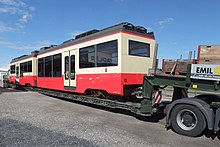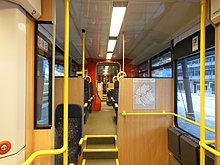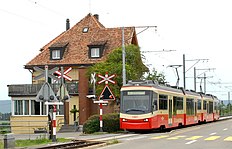FB Be 4/6
| FB Be 4/6 | |
|---|---|
|
S18, consisting of two Be 4/6, in Zurich Stadelhofen
|
|
| Numbering: | 61-73 |
| Number: | 13 |
| Manufacturer: | Stadler Rail Altenrhein |
| Year of construction (s): | 2004 |
| Axis formula : | B 0 'B 0 ' 2 ' |
| Gauge : | 1000 mm ( meter gauge ) |
| Length over coupling: | 25,147 m |
| Height: | 3650 mm |
| Width: | 2400 mm |
| Bogie axle base: | 1860 mm (drive rotation) 1700 mm (running rotation) |
| Service mass: | 33.2 t (tare) |
| Top speed: | 80 km / h |
| Short term output: | Driving / braking: 540/1696 kW (1200 V) 432/1212 kW (600 V) |
| Starting tractive effort: | 90 kN |
| Braking force: | 90 kN |
| Acceleration: | 1.2 m / s² |
| Wheel diameter: | 680 mm (new) |
| Power system : | 1200 V = , 600 V = |
| Seats: | 59 (+ 3 folding seats) |
| Standing room: | 66 (4 people / m²) |
| Floor height: | 385 mm (low floor) 860 mm (high floor) |
| Low floor: | 52% |
| Particularities: | Longitudinal compressive force: 400 kN Curve radius: ≥ 14.5 m |
The Be 4/6 of the Forchbahn (FB) are two-part tram -like electric low-floor articulated trains from the manufacturer Stadler Rail , which run on the Esslingen - Zurich Rehalp - Zurich Stadelhofen route, using the Zurich tram tracks between Rehalp and Stadelhofen . Together with the three-part Be 4/8 of the Trogenerbahn, which were built at the same time and with which they correspond in many parts, the local trains are considered to be the forerunners of the Tango tram family .
Starting position
In the city of Zurich, the Forchbahn trains run as a tram with a contact line voltage of 600 volts direct current , from Rehalp they run on their own track structure according to the rules of railway operations, with the voltage of the contact line being 1200 volts. Because of the numerous road crossings, a box strength of 400 kN is required, about twice as high as usual for trams. Because of the longer travel time than with a tram, passengers expect greater comfort with more comfortable seats and air conditioning, but fewer doors are sufficient. Traditional bogies are used instead of loose wheel sets in order to achieve smooth running and taking into account the winter snow conditions , but this makes a 100 percent low-floor proportion impossible. The concept of the articulated multiple unit with a semi-mounted sidecar made it possible to increase the low-floor area. Most of the technical equipment of the low-floor vehicles had to be housed on the roof, because the length of the sidings is too short for a drive module like the one in the GTW . Components that must be easily accessible to the staff are located under the seats.
technology
Because the Be 4/6 only have one driver's cab, they run in double or triple traction so that there is a driver's cab at each end of the train. In contrast to the successor Tango vehicles, the car bodies are still made in the aluminum construction of the GTW family (1st – 3rd generation). Because of the large swivel angle of the Schwab coupling , the Be 4/6 were given wide driver's cabs. The front coupling is retracted and covered by motor to protect other road users when not in use. In the region of the end front laterally at the bottom of stainless steel glued elements in order to collisions with road vehicles repair without welding permit. The bogies were specially developed for the Forch and Trogenerbahn family of vehicles and were also used on the Bogestra Tango trams in Bochum . The bogies are connected to the car body via a slewing ring . Thanks to air suspension, they have excellent running properties. As is customary in local transport vehicles, the wheel sets have a rubber layer between the wheel disc and wheel tire .
Each motor bogie has a power converter located on the roof. With regard to the power supply, the traction power is limited and does not reach the power of the electric brake . Nevertheless, the local trains used on steep routes are very efficient.
The Be 4/6 have a combined recuperation and resistance brake . If the network is capable of receiving it, it works as a recuperation brake. At low speeds, the vehicle control unit also activates the compressed air brake , with each wheel set having a brake disc . Every bogie is equipped with a magnetic rail brake for emergencies . The spring-loaded brake on each wheel set of the motor bogies serves as a holding brake .
The 13 multiple units have covered around 1.4 million kilometers since delivery, which is why they are now undergoing a comprehensive refit. They receive new control technology and adjustments in the driver's cab. The passenger areas will also be freshened up, there will be an additional multifunctional compartment and the floor coverings and seat covers will be renewed. The work takes around 6 months per multiple unit and is carried out by the manufacturer Stadler. Since there are not enough reserve vehicles, shortened compositions in daily operation must be expected during the entire renovation period.
Names
Only the vehicles named are listed:
| No. | Surname |
|---|---|
| 64 | Esslingen |
| 65 | Zollikerberg |
| 66 | Aesch Scheuren |
| 67 | Hinteregg |
| 68 | Egg |
| No. | Surname |
|---|---|
| 69 | Zumikon |
| 70 | Zollikon |
| 71 | Küsnacht |
| 72 | Maur |
| 73 | Zurich city |
literature
- Felix Hasler, Heinz Iwainsky, Gaudenz Burkart, Manfred Nachbaur: New electric Be 4/6 multiple units for Forchbahn AG. In: Swiss Railway Review. No. 2/2005, pp. 66-73.
- Theo Weiss: Stadler - From the tunnel locomotive to the double-decker train. Minirex, Lucerne 2010, ISBN 978-3-907014-33-2 , pp. 117-120.
Web links
- FB Be 4/6 Auf: [email protected] , accessed on August 1, 2018
- Be 4/6. On the Forchbahn website, accessed on August 1, 2018




